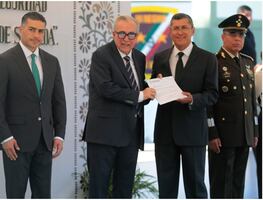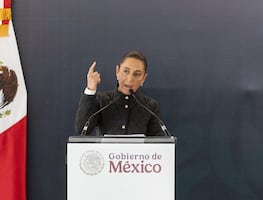Más Información

“Vamos a dar apoyo a los pequeños agricultores por sequía en Sonora”; Claudia Sheinbaum instruye a Berdegué

Derrota de México en disputa por maíz transgénico contra EU; estos son los argumentos de Sheinbaum y AMLO para prohibirlo

Óscar Rentería Schazarino, ha operado contra CJNG, Viagras y Templarios; es el nuevo secretario de Seguridad en Sinaloa

Claudia Sheinbaum pide respeto para Maru Campos; gobernadora anuncia acuerdo para transporte público

Claudia Sheinbaum anuncia los Centros de Cuidado Infantil en Chihuahua; inaugura hospital en Ciudad Juárez
November 20
will commemorate the 109 anniversary of the beginning of the Mexican Revolution . The government headed by President Andrés Manuel López Obrador announced that there will be different activities , one of them the installation of the Petra locomotive , at Mexico City’s main square.
The locomotive is named after Petra Herrera , who was the leader of a women’s brigade during the storming of Torreón . The name of the machine was chosen by the Presidential Commission for the Commemoration of Historical Facts, Processes, and Figures of Mexico , according to Felipe Ávila , director of the National Institute of Historical Studies of Mexico’s Revolutions.
The locomotive, as was informed last Tuesday in a conference by Zoé Robledo , director of the Mexican Institute of Social Security , was manufactured in 1889 , it weighs 66 tonnes and is 15.6 meters long and 3.7 meters tall.
The 130 years old machine is under the care of the Railroad Workers Museum in the Gustavo A. Madero borough, from where it will be moved to the Zócalo.
Would you like to
?
The museum is directed by Salvador Zarco , who explains that Petra is a steam locomotive of narrow gauge made by Alco (American Locomotive Company) and that was purchased by the Interoceanic Central Railroad (FCI) . In addition, it offered a mixed service, that is, it made bulk trips and transported passengers.
He adds that the machine had up to 25 wagon s and that on a single trip it transported nearly 100 persons : “Unfortunately, many locomotives of this kind have been destroyed.”
Another trip
Petra will leave its home on November 17 to make a visit to Mexico City’s main square , best known as Zócalo.
They moved her by night because there is less traffic and also for security reasons. The trip took approximately one hour. Salvador Zarco emphasized the relevance of moving Petra to the Zócalo in the anniversary of the Mexican Revolution due to the role of railroads during that time.
Have you heard of
?
“Zapata didn’t use railroads as much. He fought and sabotaged the lines and bridges to prevent the Federal Army from advancing through railroads. The Revolution could not be understood without trains ; the iron horses were fundamental during that time. Those who used them the best were Pancho Villa and General Felipe Ángeles. Railroads were so important that Venustiano Carranza seized them. Unfortunately, in Mexico, all steam locomotives are exposed to the weather and many are in poor conditions,” he says.
A unique model
Salvador Zarco says that the first locomotives worked with mules , “which was known as the blood train,” later on, locomotives that used wood for combustion were created, as well as those that worked with carbon and fuel oil. However, they were used until 1968 , when all steam locomotives were canceled, too.
After being out of service in 1968, Petra was put in the back of the Monument to the Revolution , until it was moved to the Railroad Workers Museum on May 24, 2010, after a donation by the Public Space Authority of Mexico City .
Petra is painted in black, silver, and red, and it has the number 67 and the letters FCI . It looks as new, however, many parts have been stolen from the machine.
Have you heard of the
?
“Since it was put out of service (1968), it was sent to a concentration field in Huehuetoca, State of Mexico ; it was abandoned there. It was in that locomotives cemetery until some politician decided to take it out and bring it to some workshops in Tlalnepantla , where they fixed it to take it to the Republic Square , where it was not well-cared for, anyone got on it; there were even homeless people who lit fires inside the cabin, and the boiler was used as trashcan,” he says.
In 2010 , Petra was restored and transferred to the museum, an action that Zarco qualifies as “a success,” although he acknowledges it is missing some parts, such as gauges, valves, and parts of the bell.
“We want Petra to be under a roof in the future, protected from the sun and the rain so that it is better preserved. The relevance of preserving (Petra and other locomotives of the time) lies in preserving the historical memory of the country and it is fundamental right now because we need our people to see locomotives and trains because it is the best transport for all kinds of human activity. Countries in Europe and Asia use it mainly for bulk trips and for passengers. Railroads are not only the cheapest, friendliest with the environment, and most comfortable transport, but also the safest,” he says.
Focusing on Petra, Zarco describes that this kind of locomotives was a “beauty, they were dragons that expelled sparks everywhere,” Besides, he remembers they were assigned to a single crew .
“Only one operator was in charge of her; only he used it. Each operator had a whistle with a different sound, so every time a locomotive arrived at a station, it could be known which was it only by the sound of the whistle. Today, its transfer will not be complicated and it doesn’t represent any kind of risk,” he adds.
Once it arrived at Mexico City’s Zócalo , the locomotive joined two vehicles, the Exprés NM-7558 and the second class passengers NM 966 which were used during the Mexican Revolution to transport troops, weapons, and food, and everything that was used for the armed fight and to provide supplies for the army.
The recreation of the train will be available until Sunday, November 25 as informed Salvador Zarco.
Have you heard there is a
?
mp





